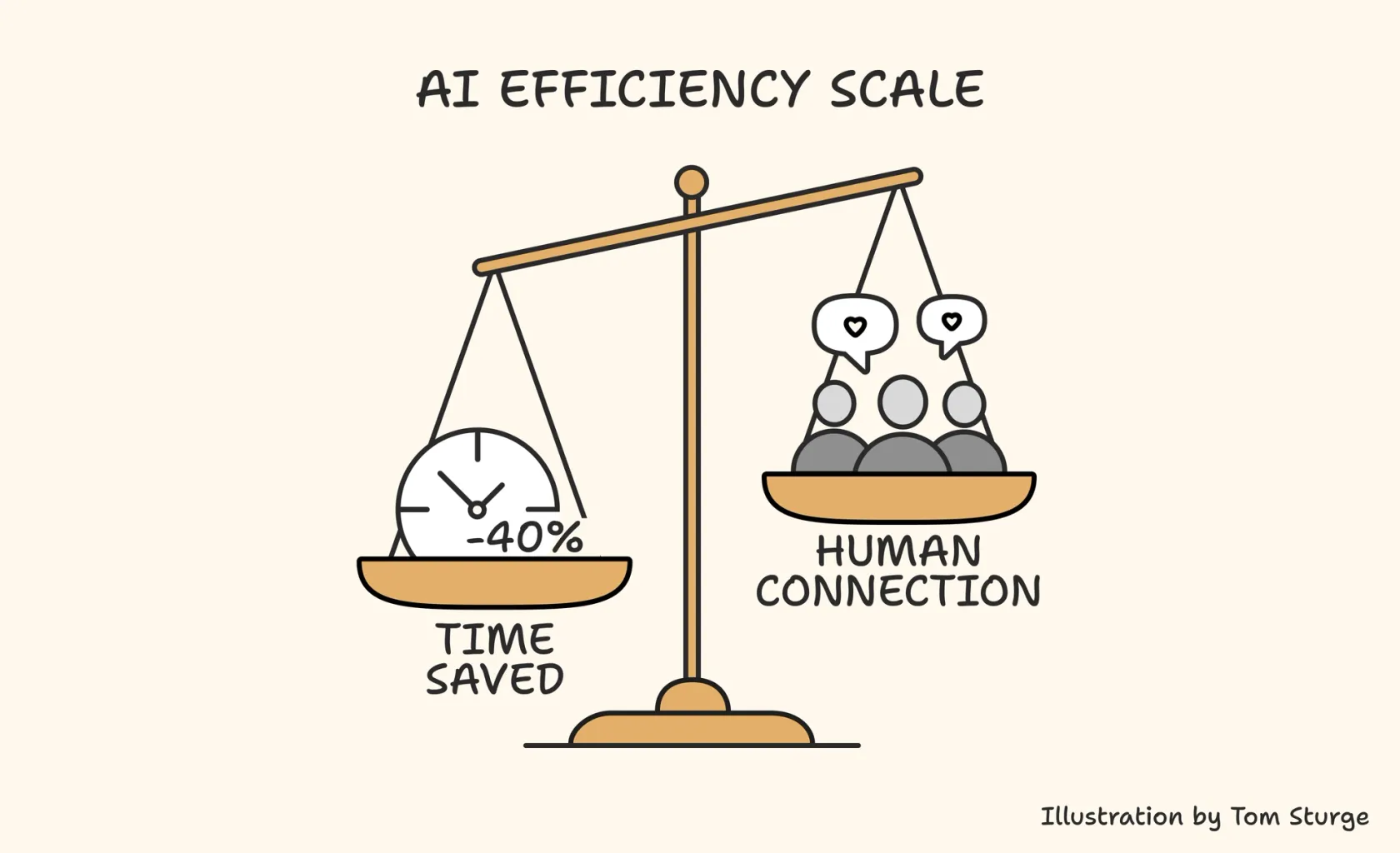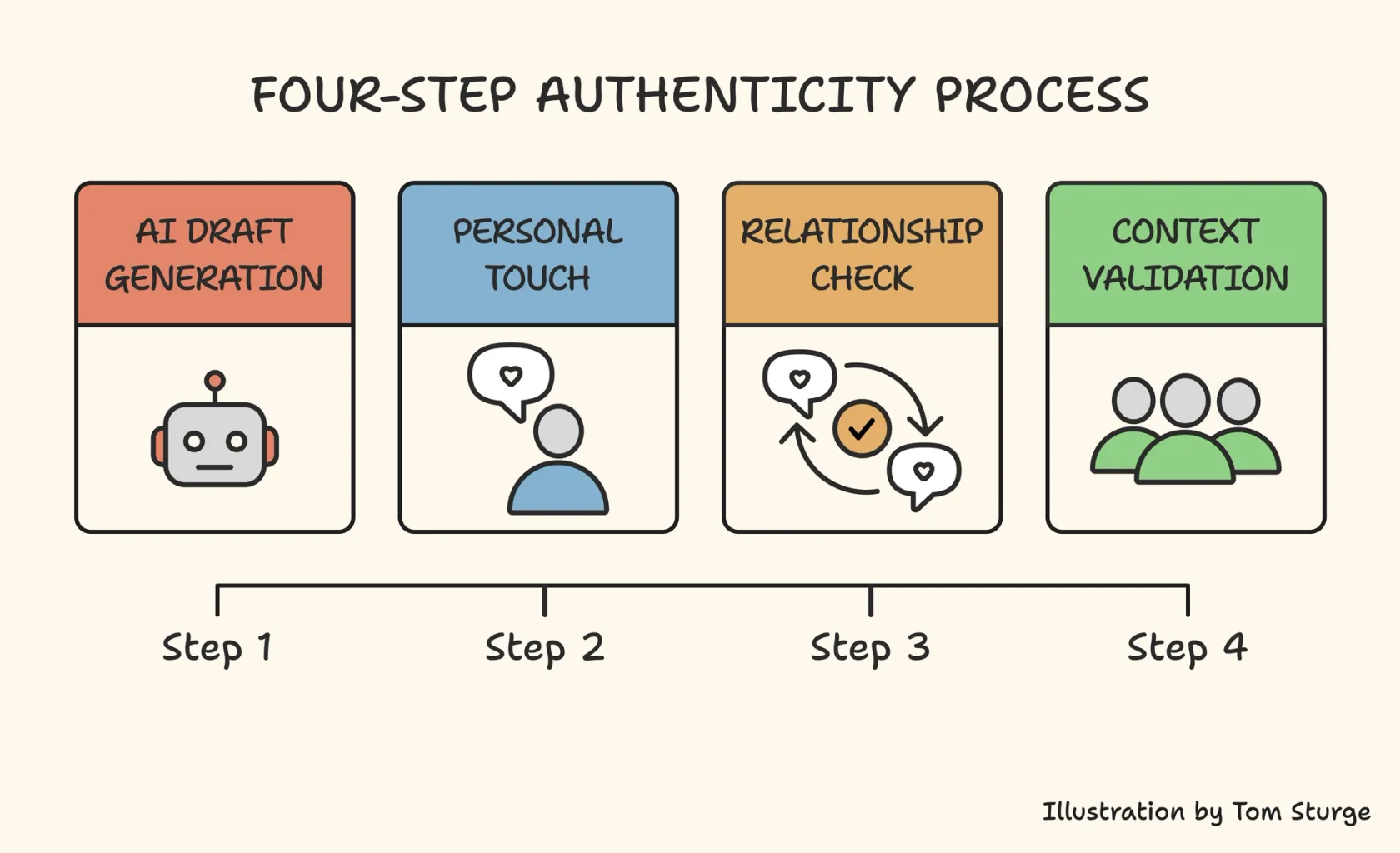The Monday morning email from your team lead arrives perfectly structured, grammatically flawless, and completely forgettable. Every sentence reads like it came from the same corporate communication template, devoid of the personality that once made her messages feel genuinely human.
This scenario plays out across organisations everywhere. AI email assistants have exploded in popularity, with businesses rapidly adopting these tools to streamline communication workflows. Yet this efficiency surge comes at a hidden cost that most leaders haven't recognised.
AI challenges authorship itself, when does convenience compromise authenticity? We're creating an authenticity crisis where AI-generated text feels detached, missing the emotional weight and human presence that drives workplace culture.
Through years of building engineering teams, I've learned that communication isn't just about information transfer. It's about building trust, demonstrating care, and creating authentic dialogue that drives team performance. The question isn't whether to use AI tools, but how to leverage them without losing the human connection that makes leadership effective.
Where AI Wins and Where It Fails
The Efficiency Promise That Actually Delivers
The benefits are undeniable. Research documented by the Digital Society Blog demonstrates that AI tools can significantly reduce the time spent on writing tasks, making leaders more efficient at handling routine communications.
AI excels at routine administrative communications, initial draft generation, grammar improvements, and standardising tone across team communications. When you need to send project updates to stakeholders or schedule team meetings, AI handles these tasks brilliantly.

The Authenticity Gaps AI Can't Bridge
But here's where the promise breaks down. Research reveals that AI struggles with nuance. In high-stakes situations, such as condolences, negotiations, and performance reviews, AI may generate technically correct responses but miss the emotional weight behind them.
Analysis from Spike identifies the core challenge: AI messages are often too polished and structured, lacking the slight hesitations and quirks that make human communication feel real. The challenge runs deeper than most leaders realise.
Consider the essential elements of leadership communication that AI cannot replicate: building relationships and trust, conveying subtle context, demonstrating genuine care and attention, expressing unique perspectives, and creating authentic dialogue. The best conversations aren't just efficient, they encourage engagement.
The Hidden Cost of Efficiency-First Communication
When Perfect Grammar Kills Personal Connection
Here's what most leaders miss about the AI communication trap. Research warns that while using AI for emails can make us more efficient, it carries the risk of eroding our communication skills. We lose our ability to find the right words and tone in situations where we cannot rely on AI.
The workplace communication crisis runs deeper than many leaders recognise. Poor communication consistently affects trust in leadership relationships. Research consistently shows that employees lose confidence in leaders who communicate in ways that feel disconnected or impersonal. When your team starts receiving messages that feel automated, you're contributing to this trust erosion without realising it.
"Most employees agree that the perceived lack of trust their company leadership has in them impacts their ability to do their jobs well." PwC Trust in Business Survey
This perception gap between leaders and employees often stems from communication that feels disconnected from genuine leadership engagement.
The Emotional Labour of Authenticity
There's real value in the effort of crafting your own messages. Writing is thinking. When you write your own performance feedback or team updates, you process the content differently. You consider nuances that matter. You express emotions and communicate authentically.
Consider this scenario: a team lead uses AI to write performance feedback. The result is technically accurate but emotionally hollow, missing opportunities for genuine development conversations. The team member receives criticism that feels disconnected from their actual relationship with their manager.
This emotional dissonance has real consequences. Teams become accustomed to leader communication that feels automated, reducing the emotional impact and personal connection that drives engagement and loyalty. When recognition feels scripted or feedback lacks personal insight, employees naturally disengage from both the message and the messenger.
Building Your Human-AI Communication Framework
The solution isn't abandoning AI tools. It's using them strategically through a clear framework that preserves authentic connection whilst capturing efficiency benefits.
The Strategic Filter Approach
High-Stakes, Human-Led Communications:
- Performance reviews and difficult conversations
- Crisis communications and sensitive announcements
- Team celebration and recognition messages
- Strategic vision and direction-setting communications
AI-Assisted, Human-Polished Communications:
- Project updates and status reports
- Meeting follow-ups and action items
- Routine administrative messaging
- Initial drafts for complex topics requiring human refinement
The Authenticity Integration Method
When you do use AI assistance, follow this process:
Step 1: AI Draft Generation - Use AI for structure, grammar, and initial content organisation.
Step 2: Add Personal Touch - Add personal experiences, specific examples, and emotional context that reflect your leadership style.
Step 3: Relationship Check - Ask yourself: "Does this sound like me?" and "Will this strengthen or weaken team connection?"
Step 4: Context Validation - Ensure the message addresses underlying team dynamics and unspoken concerns that only human insight can identify.

Here's a practical example. Transform an AI-generated project update by adding personal observations about team performance, acknowledging specific challenges individuals are facing, and expressing genuine appreciation for effort rather than just results.
Preserving Your Signature Style
Develop personal communication markers that remain consistent across all your messages:
- Signature phrases and expressions that reflect your leadership approach
- Consistent method for recognising team contributions
- Personal anecdotes and examples that illustrate your points
- Specific feedback style that team members recognise as uniquely yours
Making This Work for Your Team
Building Team Awareness
Be transparent about your AI usage. Help team members understand when and how you use AI assistance, maintaining trust through openness about your communication process. This isn't about confession, it's about setting clear expectations around when personal voice matters most.
Create team norms around AI-assisted versus human-first communication. Your team should understand the difference between efficiency-focused updates and relationship-building conversations.
Measuring Impact on Team Dynamics
Watch for warning signs that AI usage is affecting team relationships:
- Decreased engagement with your messages
- Reduced team response rates and interaction
- Feedback that communication feels impersonal or generic
- Loss of the informal relationship-building that drives team performance
Success indicators include maintained team trust scores, continued personal connections during one-to-ones, and preserved team culture where people still seek your input on complex decisions.
The importance of monitoring these indicators becomes clear when you consider how feedback quality affects leadership trust. Research shows that leaders who take meaningful action based on employee input consistently build stronger team relationships than those who gather feedback but fail to act on it.
"Nothing causes employees to disengage more than vague and disingenuous internal communication. It erodes trust, lowers morale, and decreases productivity." Axios HQ Internal Communication Research
This finding highlights why the quality of leader communication, not just its efficiency, becomes critical to maintaining team engagement and loyalty.
Technology as Tool, Not Replacement
The most effective strategy is human-led, AI-assisted, where AI handles the mundane so you can focus on the meaningful. Great leaders use AI to amplify their authentic voice rather than replace it.
Start by auditing your current communication approach. Which messages are you auto-generating versus personally crafting? Where might efficiency be undermining the team relationships that drive real performance? Most importantly, are your team members still bringing you their toughest challenges, or have they stopped seeking your guidance on complex decisions?
In an AI-saturated workplace, authentic human communication becomes more valuable, not less. The leaders who master this balance will build stronger teams, drive better outcomes, and maintain the human connections that separate great leadership from efficient management.
The choice isn't between AI and authenticity. It's about using technology to enhance rather than replace the human elements that make leadership effective. Your team doesn't need perfect emails. They need to hear from their leader.




